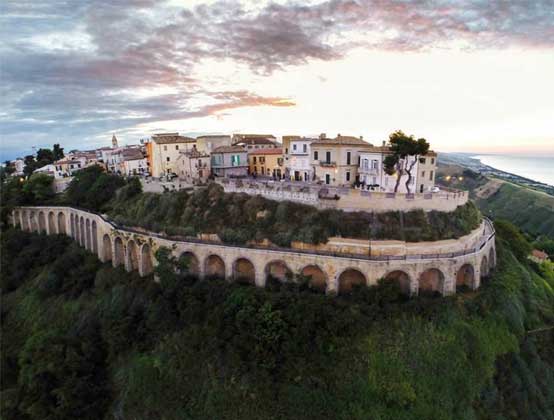Considered one of the most beautiful beaches in Abruzzo, Silvi Marina has a sandy shore that extends from the Tower of Cerrano (south of Pineto) to the mouth of the Tavo river, with the large apartment buildings of Montesilvano Marina in the background. We are north of Pescara and although the original village is more inland, called Silvi Alta, iwith beautiful views of the Adriatic, the tourist boom of the last century has developed more in Silvi Marina.
The upper part of the city is the site of the first Roman settlements: thanks to the high altitude at about 240 m, and with excellent views of the coast. The name indicates a probable presence of woods that covered the coastal hills (Silvae). During the Middle Ages, the village was under the direction of the city of Teramo and nearby Atri.
Silvi Marina owes its tourist success also to its typical Mediterranean climate, characterized by hot and dry summers, with an average temperature of around 24-25 °C which makes the days spent on the beach really pleasant. The rains fall mainly
in autumn, and are on average with the typical temperatures of the Adriatic coast, while in winter the climate is usually mild, it can also get cold and at times it has been known to snow on the coast.
The beach covers a total of over 8 km, but the one closely linked to the city center has a front of just under 5 km. The beach is sandy and has a maximum depth of almost a hundred meters in the most developed areas. The abundance of sand means that its coast has not yet been protected by cliffs and brush docks (not in the southernmost end), thus preserving its natural Adriatic beauty for now.
The beautiful Torre di Cerrano is here, which remains in the territory of Pineto. To reach it on foot from Silvi, along the beach, it takes about 1 hour by foot, but it's definitely worth it. It is a building that was part of the ancient coastal towers of the Kingdom of Naples, and remains surrounded by a splendid handful of imposing maritime pines, which also make it a magnificent place for photographs.
One of the best ways to get to Silvi Marina is by train. This means of transport was one of the reasons for its tourist development, starting in 1863, the year in which the important Adriatic artery was inaugurated. The Silvi station is located in the city center, and from there you can reach the beautiful beach in just a few minutes. The most important trains stop at the nearby Pescara station, which also has connections to Rome, and from here you can take a local train.
For those arriving by car the best route is the A-14 motorway, with Atri-Pineto exits (for those coming from the north) or Pescara Nord-Città S. Angelo. This is the best, especially for those coming from the south. The nearest airport is that of Pescara, from here there are direct connections with the Pescara railway station, from there you can reach Silvi Marina in a few minutes.
Via Garibaldi, 57 - 64029
SILVI MARINA | ITALIA
Phone : 085 935 2528 | 366 346 7657
Email: merloni.silvi@gmail.com
It stands like a bow of a ship, on the crest of a hill at an altitude of 240 meters. It extends to the sea on the golden beaches of the Adriatic, in a splendid landscape that is surrounded by lush hills. It is embraced behind by the mountain ranges of the Gran Sasso of Italy and the Majella, enclosing it as a real jewel.
Le sue origini affondano radici in tempi lontani. Lo stesso toponimo fa riferimento alla primitiva natura boschiva selvae che, It offers one of the most evocative and complete scenic views of the entire Adriatic coast, ranging from Monte Conero, the Umbrian Apennines of the Marche region, to the Gargano promontory in Puglia.


The Torre di Cerrano owes its name to the stream of the same name, currently located 500 meters to the south, at the mouth of what was the ancient port of Hatria (Atri), once a port of call in the service of the hill town. The location of the port in the waters, in front of the tower, represented an important contact between those who came from the sea and those who lived on land. Cnce the river transport was advantageous from an economic point of view and faster than travel by road or animal since there was no need to rest and feed. The boats could circulate without stopping, supporting a large number of heavy crates: wheat, coal, wood, salt. They also carried large blocks for the construction of castles and the Cathedral. Barrels of wine, oil, wood, etc. were loaded on board. It was certainly more difficult to go upstream, which took longer and required frequent hauling: towing the boat from the shore with a cable pulled by men or animals. The boats also had a flat bottom so as not to run aground on sandbanks and the sail helped with the current.

Via Garibaldi, 57 - 64028
SILVI MARINA | ITALIA
085 935 2528 | +39 351 351 2934
E-mail: casaperferiemerloni@gmail.com